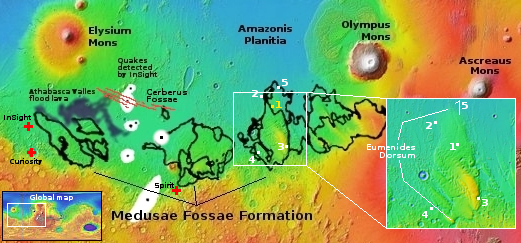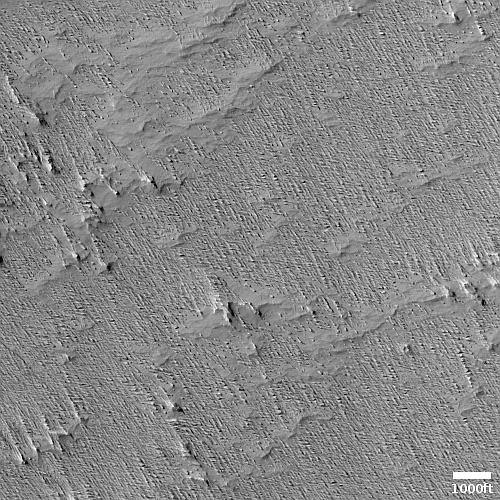The prevailing winds in Mars’ volcano country
Today’s cool image is actual one new picture and four past images, which taken together reveal something about the larger wind patterns on Mars. The picture to the right, cropped, reduced, and sharpened to post here, was taken on June 27, 2023 by the high resolution camera on Mars Reconnaissance Orbiter (MRO) and shows a tiny wind-swept section of the giant volcanic ash field dubbed the Medusae Fossae Formation, about the size of the subcontinent of India and thought to be source of most of the dust on Mars.
The innumerable parallel thin ridges here all suggest that the prevailing winds blow from the southeast to the northwest. As they blow, the scour the surface ash out, and sometimes reveal the underlying bedrock, which here shows up as those small peaks and a handful of northeast-to-southwest trending larger ridges. Note too that the picture shown is only a small section of the full image, which shows that this landscape continues for a considerable distance in all directions.

The yellow dot labeled #1 on the overview map to the right marks this location. The four surrounding dots are previous cool images of other locations in the Medusae Fossae Formation, all found on the edges or inside the giant 700-mile-long mound dubbed Eumenides Dorsum. Numbers #2, #4, and #5 all indicate the same direction for the prevailing winds, from the southeast to the northwest. Apparently, as the thick mound of volcanic ash that comprises Eumenides Dorsum descends to the northwest the wind blows along its length, taking the ash in that direction until it peters out around image #5.
Only at cool image #3 do the prevailing winds blow in a different direction, from the west to the east. The reason however is clear. This location is inside an east-west oriented canyon that cuts into Eumenides Dorum, and the wind appears to be directed into that canyon and follow its path out eastward into the wider plains.
That the pattern of those southeast-to northwest prevailing winds however appears to extend over an area more than 700 miles long and 400 miles wide tells us much about the Martian atmosphere and weather patterns. The patterns are large, and also long-lived, as that thin atmosphere needed a lot of time to carve this ridge pattern across such a wide area.
On Christmas Eve 1968 three Americans became the first humans to visit another world. What they did to celebrate was unexpected and profound, and will be remembered throughout all human history. Genesis: the Story of Apollo 8, Robert Zimmerman's classic history of humanity's first journey to another world, tells that story, and it is now available as both an ebook and an audiobook, both with a foreword by Valerie Anders and a new introduction by Robert Zimmerman.
The print edition can be purchased at Amazon or from any other book seller. If you want an autographed copy the price is $60 for the hardback and $45 for the paperback, plus $8 shipping for each. Go here for purchasing details. The ebook is available everywhere for $5.99 (before discount) at amazon, or direct from my ebook publisher, ebookit. If you buy it from ebookit you don't support the big tech companies and the author gets a bigger cut much sooner.
The audiobook is also available at all these vendors, and is also free with a 30-day trial membership to Audible.
"Not simply about one mission, [Genesis] is also the history of America's quest for the moon... Zimmerman has done a masterful job of tying disparate events together into a solid account of one of America's greatest human triumphs."--San Antonio Express-News
Today’s cool image is actual one new picture and four past images, which taken together reveal something about the larger wind patterns on Mars. The picture to the right, cropped, reduced, and sharpened to post here, was taken on June 27, 2023 by the high resolution camera on Mars Reconnaissance Orbiter (MRO) and shows a tiny wind-swept section of the giant volcanic ash field dubbed the Medusae Fossae Formation, about the size of the subcontinent of India and thought to be source of most of the dust on Mars.
The innumerable parallel thin ridges here all suggest that the prevailing winds blow from the southeast to the northwest. As they blow, the scour the surface ash out, and sometimes reveal the underlying bedrock, which here shows up as those small peaks and a handful of northeast-to-southwest trending larger ridges. Note too that the picture shown is only a small section of the full image, which shows that this landscape continues for a considerable distance in all directions.

The yellow dot labeled #1 on the overview map to the right marks this location. The four surrounding dots are previous cool images of other locations in the Medusae Fossae Formation, all found on the edges or inside the giant 700-mile-long mound dubbed Eumenides Dorsum. Numbers #2, #4, and #5 all indicate the same direction for the prevailing winds, from the southeast to the northwest. Apparently, as the thick mound of volcanic ash that comprises Eumenides Dorsum descends to the northwest the wind blows along its length, taking the ash in that direction until it peters out around image #5.
Only at cool image #3 do the prevailing winds blow in a different direction, from the west to the east. The reason however is clear. This location is inside an east-west oriented canyon that cuts into Eumenides Dorum, and the wind appears to be directed into that canyon and follow its path out eastward into the wider plains.
That the pattern of those southeast-to northwest prevailing winds however appears to extend over an area more than 700 miles long and 400 miles wide tells us much about the Martian atmosphere and weather patterns. The patterns are large, and also long-lived, as that thin atmosphere needed a lot of time to carve this ridge pattern across such a wide area.
On Christmas Eve 1968 three Americans became the first humans to visit another world. What they did to celebrate was unexpected and profound, and will be remembered throughout all human history. Genesis: the Story of Apollo 8, Robert Zimmerman's classic history of humanity's first journey to another world, tells that story, and it is now available as both an ebook and an audiobook, both with a foreword by Valerie Anders and a new introduction by Robert Zimmerman.
The print edition can be purchased at Amazon or from any other book seller. If you want an autographed copy the price is $60 for the hardback and $45 for the paperback, plus $8 shipping for each. Go here for purchasing details. The ebook is available everywhere for $5.99 (before discount) at amazon, or direct from my ebook publisher, ebookit. If you buy it from ebookit you don't support the big tech companies and the author gets a bigger cut much sooner.
The audiobook is also available at all these vendors, and is also free with a 30-day trial membership to Audible.
"Not simply about one mission, [Genesis] is also the history of America's quest for the moon... Zimmerman has done a masterful job of tying disparate events together into a solid account of one of America's greatest human triumphs."--San Antonio Express-News


